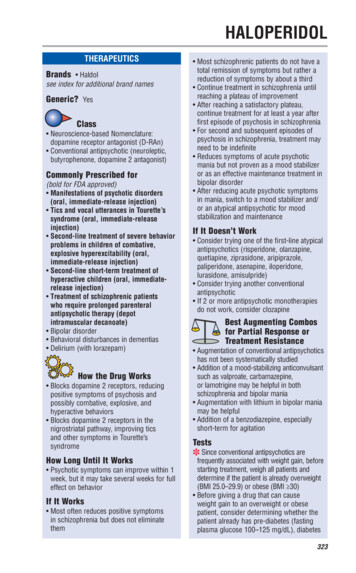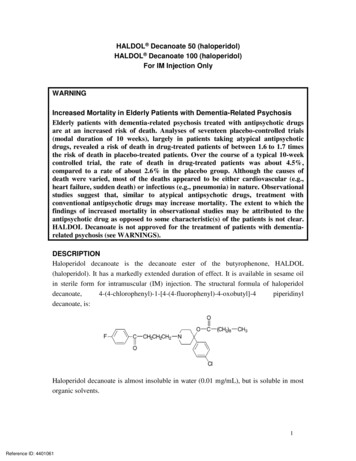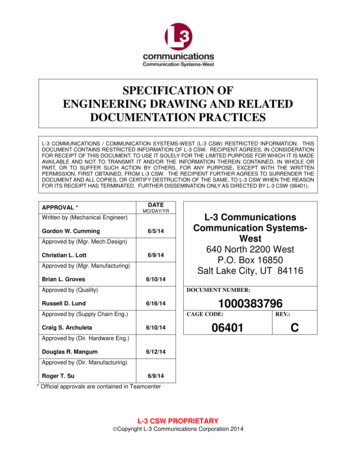
Transcription
HALOPERIDOLTHERAPEUTICSBrands Haldolsee index for additional brand namesGeneric? YesClass Neuroscience-based Nomenclature:dopamine receptor antagonist (D-RAn) Conventional antipsychotic (neuroleptic,butyrophenone, dopamine 2 antagonist)Commonly Prescribed for(bold for FDA approved) Manifestations of psychotic disorders(oral, immediate-release injection) Tics and vocal utterances in Tourette’ssyndrome (oral, immediate-releaseinjection) Second-line treatment of severe behaviorproblems in children of combative,explosive hyperexcitability (oral,immediate-release injection) Second-line short-term treatment ofhyperactive children (oral, immediaterelease injection) Treatment of schizophrenic patientswho require prolonged parenteralantipsychotic therapy (depotintramuscular decanoate) Bipolar disorder Behavioral disturbances in dementias Delirium (with lorazepam)How the Drug Works Blocks dopamine 2 receptors, reducingpositive symptoms of psychosis andpossibly combative, explosive, andhyperactive behaviors Blocks dopamine 2 receptors in thenigrostriatal pathway, improving ticsand other symptoms in Tourette’ssyndromeHow Long Until It Works Psychotic symptoms can improve within 1week, but it may take several weeks for fulleffect on behaviorIf It Works Most often reduces positive symptomsin schizophrenia but does not eliminatethem Most schizophrenic patients do not have atotal remission of symptoms but rather areduction of symptoms by about a third Continue treatment in schizophrenia untilreaching a plateau of improvement After reaching a satisfactory plateau,continue treatment for at least a year afterfirst episode of psychosis in schizophrenia For second and subsequent episodes ofpsychosis in schizophrenia, treatment mayneed to be indefinite Reduces symptoms of acute psychoticmania but not proven as a mood stabilizeror as an effective maintenance treatment inbipolar disorder After reducing acute psychotic symptomsin mania, switch to a mood stabilizer and/or an atypical antipsychotic for moodstabilization and maintenanceIf It Doesn’t Work Consider trying one of the first-line atypicalantipsychotics (risperidone, olanzapine,quetiapine, ziprasidone, aripiprazole,paliperidone, asenapine, iloperidone,lurasidone, amisulpride) Consider trying another conventionalantipsychotic If 2 or more antipsychotic monotherapiesdo not work, consider clozapineBest Augmenting Combosfor Partial Response orTreatment Resistance Augmentation of conventional antipsychoticshas not been systematically studied Addition of a mood-stabilizing anticonvulsantsuch as valproate, carbamazepine,or lamotrigine may be helpful in bothschizophrenia and bipolar mania Augmentation with lithium in bipolar maniamay be helpful Addition of a benzodiazepine, especiallyshort-term for agitationTests Since conventional antipsychotics arefrequently associated with weight gain, beforestarting treatment, weigh all patients anddetermine if the patient is already overweight(BMI 25.0–29.9) or obese (BMI 30) Before giving a drug that can causeweight gain to an overweight or obesepatient, consider determining whether thepatient already has pre-diabetes (fastingplasma glucose 100–125 mg/dL), diabetes323
HALOPERIDOL (continued)(fasting plasma glucose 126 mg/dL), ordyslipidemia (increased total cholesterol,LDL cholesterol, and triglycerides;decreased HDL cholesterol), and treat orrefer such patients for treatment, includingnutrition and weight management, physicalactivity counseling, smoking cessation, andmedical management Monitor weight and BMI during treatment Consider monitoring fasting triglyceridesmonthly for several months in patients athigh risk for metabolic complications andwhen initiating or switching antipsychotics While giving a drug to a patient whohas gained 5% of initial weight, considerevaluating for the presence of pre-diabetes,diabetes, or dyslipidemia, or considerswitching to a different antipsychotic Should check blood pressure in the elderlybefore starting and for the first few weeksof treatment Monitoring elevated prolactin levels ofdubious clinical benefit Patients with low white blood cell count(WBC) or history of drug-inducedleucopenia/neutropenia should havecomplete blood count (CBC) monitoredfrequently during the first few months andhaloperidol should be discontinued at thefirst sign of decline of WBC in the absenceof other causative factorsNotable Side Effects Neuroleptic-induced deficit syndrome Akathisia Extrapyramidal symptoms, parkinsonism,tardive dyskinesia, tardive dystonia Galactorrhea, amenorrhea Dizziness, sedation Dry mouth, constipation, urinary retention,blurred vision Decreased sweating Hypotension, tachycardia, hypertension Weight gainLife-Threatening orDangerous Side Effects Rare neuroleptic malignant syndrome Rare seizures Rare jaundice, agranulocytosis, leukopenia Increased risk of death and cerebrovascularevents in elderly patients with dementiarelated psychosisWeight Gain Occurs in significant minoritySedation Sedation is usually transientWhat to Do About Side EffectsSIDE EFFECTSHow Drug Causes Side Effects By blocking dopamine 2 receptors in thestriatum, it can cause motor side effects By blocking dopamine 2 receptors inthe pituitary, it can cause elevations inprolactin By blocking dopamine 2 receptorsexcessively in the mesocortical andmesolimbic dopamine pathways, especiallyat high doses, it can cause worseningof negative and cognitive symptoms(neuroleptic-induced deficit syndrome) By blocking alpha 1 adrenergic receptors,it can cause dizziness, sedation, andhypotension Mechanism of weight gain and anypossible increased incidence of diabetesor dyslipidemia with conventionalantipsychotics is unknown324 Wait Wait Wait For motor symptoms, add ananticholinergic agent Reduce the dose For sedation, give at night Switch to an atypical antipsychotic Weight loss, exercise programs, andmedical management for high BMIs,diabetes, dyslipidemiaBest Augmenting Agents for SideEffects Benztropine or trihexyphenidyl for motorside effects Sometimes amantadine can be helpful formotor side effects Benzodiazepines may be helpful for akathisia Many side effects cannot be improved withan augmenting agent
(continued)DOSING AND USEUsual Dosage RangeOverdose Fatalities have been reported;extrapyramidal symptoms, hypotension,sedation, respiratory depression, shock-likestate 1–40 mg/day orally Immediate-release injection 2–5 mg eachdose Decanoate injection 10–20 times theprevious daily dose of oral antipsychotic(see Haloperidol Decanoate section afterPearls for dosing and use)Long-Term UseDosage FormsHabit Forming Tablet 0.5 mg scored, 1 mg scored,2 mg scored, 5 mg scored, 10 mg scored,20 mg scored Concentrate 2 mg/mL Solution 1 mg/mL Injection 5 mg/mL (immediate-release) Decanoate injection 50 mg /mL,100 mg/mLHow to Dose Oral: initial 1–15 mg/day; can give oncedaily or in divided doses at the beginningof treatment during rapid dose escalation;increase as needed; can be dosed up to100 mg/day; safety not established fordoses over 100 mg/day Immediate-release injection: initial dose2–5 mg; subsequent doses may be givenas often as every hour; patient should beswitched to oral administration as soon aspossibleHALOPERIDOL Often used for long-term maintenance Some side effects may be irreversible(e.g., tardive dyskinesia) NoHow to Stop Slow down-titration of oral formulation(over 6–8 weeks), especially whensimultaneously beginning a newantipsychotic while switching (i.e., crosstitration) Rapid oral discontinuation may lead torebound psychosis and worsening ofsymptoms If antiparkinson agents are being used,they should be continued for a few weeksafter haloperidol is discontinuedPharmacokinetics Decanoate half-life approximately 3 weeks Oral half-life approximately 12–38 hoursDrug InteractionsDosing Tips – Oral Haloperidol is frequently dosed too high Some studies suggest that patients whorespond well to low doses of haloperidol(e.g., approximately 2 mg/day) may haveefficacy similar to atypical antipsychoticsfor both positive and negative symptoms ofschizophrenia Higher doses may actually induceor worsen negative symptoms ofschizophrenia Low doses, however, may not havebeneficial actions for treatment-resistantcases or violence One of the only antipsychotics with a depotformulation lasting for up to a month Treatment should be suspended ifabsolute neutrophil count falls below1,000/mm3 May decrease the effects of levodopa,dopamine agonists May increase the effects of antihypertensivedrugs except for guanethidine, whoseantihypertensive actions haloperidol mayantagonize Additive effects may occur if used withCNS depressants; dose of other agentshould be reduced Some pressor agents (e.g., epinephrine)may interact with haloperidol to lowerblood pressure Haloperidol and anticholinergic agentstogether may increase intraocular pressure Reduces effects of anticoagulants Plasma levels of haloperidol may belowered by rifampin Some patients taking haloperidol andlithium have developed an encephalopathicsyndrome similar to neuroleptic malignantsyndrome325
HALOPERIDOL (continued) May enhance effects of antihypertensivedrugsOther Warnings/Precautions If signs of neuroleptic malignant syndromedevelop, treatment should be immediatelydiscontinued Use with caution in patients withrespiratory disorders Avoid extreme heat exposure If haloperidol is used to treat mania,patients may experience a rapid switch todepression Patients with thyrotoxicosis mayexperience neurotoxicity Use only with caution if at all in Parkison’sdisease or Lewy body dementia Higher doses and IV administration maybe associated with increased risk of QTprolongation and torsades de pointes;use particular caution if patient has aQT-prolonging condition, underlyingcardiac abnormalities, hypothyroidism,familial long-QT syndrome, or is taking adrug known to prolong QT intervalDo Not Use If patient is in comatose state or has CNSdepression If patient has Parkinson’s disease If there is a proven allergy to haloperidolSPECIAL POPULATIONSRenal Impairment Use with cautionHepatic Impairment Use with cautionCardiac Impairment Use with caution because of risk oforthostatic hypertension Possible increased risk of QT prolongationor torsades de pointes at higher doses orwith IV administrationElderly Lower doses should be used and patientshould be monitored closely Elderly patients may be more susceptible torespiratory side effects and hypotension326 Although conventional antipsychoticsare commonly used for behavioraldisturbances in dementia, no agent hasbeen approved for treatment of elderlypatients with dementia-related psychosis Elderly patients with dementia-relatedpsychosis treated with antipsychotics areat an increased risk of death compared toplacebo, and also have an increased risk ofcerebrovascular eventsChildren and Adolescents Safety and efficacy have not beenestablished; not intended for use under age 3 Oral: initial 0.5 mg/day; target dose0.05–0.15 mg/kg per day for psychoticdisorders; 0.05–0.075 mg/kg per day fornonpsychotic disorders Generally consider second-line afteratypical antipsychoticsPregnancy Effective June 30, 2015, the US FDArequires changes to the content and formatof pregnancy and lactation informationin prescription drug labels, includingthe elimination of the pregnancy lettercategories; the Pregnancy and LactationLabeling Rule (PLLR or final rule) appliesonly to prescription drugs and will bephased in gradually for drugs approved onor after June 30, 2001 Controlled studies have not beenconducted in pregnant women There is a risk of abnormal musclemovements and withdrawal symptomsin newborns whose mothers took anantipsychotic during the third trimester;symptoms may include agitation,abnormally increased or decreased muscletone, tremor, sleepiness, severe difficultybreathing, and difficulty feeding Reports of extrapyramidal symptoms,jaundice, hyperreflexia, hyporeflexia ininfants whose mothers took a conventionalantipsychotic during pregnancy Reports of limb deformity in infantswhose mothers took haloperidol duringpregnancy Haloperidol should generally not be usedduring the first trimester
(continued) Haloperidol should only be used duringpregnancy if clearly needed Psychotic symptoms may worsen duringpregnancy and some form of treatmentmay be necessary Atypical antipsychotics may be preferableto conventional antipsychotics oranticonvulsant mood stabilizers if treatmentis required during pregnancyBreast Feeding Some drug is found in mother’s breast milk Recommended either to discontinue drugor bottle feedTHE ART OF PSYCHOPHARMACOLOGYPotential Advantages Intramuscular formulation for emergencyuse 4-week depot formulation for noncompliance Low-dose responders may havecomparable positive and negative symptomefficacy to atypical antipsychotics Low-cost, effective treatmentPotential Disadvantages Patients with tardive dyskinesia or whowish to avoid tardive dyskinesia andextrapyramidal symptoms Vulnerable populations such as children orelderly Patients with notable cognitive or moodsymptomsPrimary Target Symptoms Positive symptoms of psychosis Violent or aggressive behaviorPearls Prior to the introduction of atypicalantipsychotics, haloperidol was one of themost preferred antipsychotics Haloperidol may still be a usefulantipsychotic, especially at low doses forthose patients who require managementwith a conventional antipsychotic or whocannot afford an atypical antipsychotic Low doses may not induce negativesymptoms, but high doses may Not clearly effective for improvingcognitive or affective symptoms ofschizophreniaHALOPERIDOL May be effective for bipolar maintenance,but there may be more tardive dyskinesiawhen affective disorders are treated with aconventional antipsychotic long-term Less sedating than many otherconventional antipsychotics, especially“low potency” phenothiazines Ha
Notable Side Effects Neuroleptic-induced deficit syndrome Akathisia Extrapyramidal symptoms, parkinsonism, tardive dyskinesia, tardive dystonia Galactorrhea, amenorrhea Dizziness, sedation Dry mouth, constipation, urinary retention, blurred vision Decreased sweating











